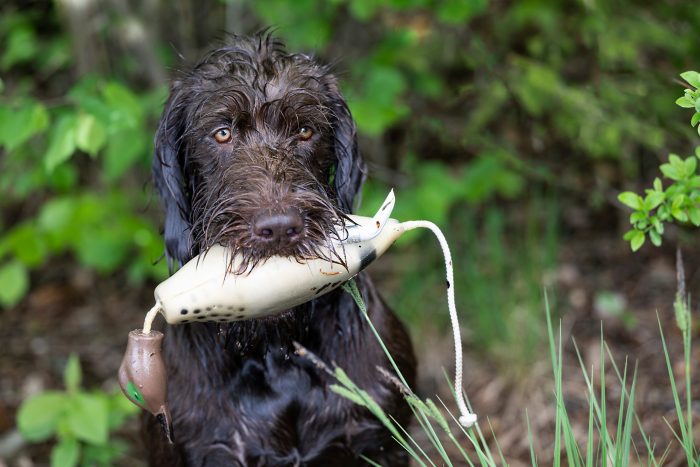
A Pointer and a Poodle walk into a bar. The Poodle says, “I bet I can find the best spot in this bar.” The Pointer looks around and replies, “Well, I’ll fetch the drinks, but only if they’re not ‘foo foo’ drinks.”
Badaboom.
Try as we might, we couldn’t get ChatGPT to come up with anything funnier. We tried rephrasing the set up line (seen italicized):
Half a century before František Horák developed the Cesky by crossing a Sealyham Terrier and a Scottish Terrier to create a terrier better suited to hunt in Bohemian forests, German hunters began the systematic crossing of Pudels and Pointers. Specifically, it was Baron von Zedlitz und Trützschler whose goal was to create a versatile hunting dog that excelled in both land and water retrieval. He selected two breeds, one known for exceptional tracking abilities, the other for its pointing and retrieving skills.
It’s important to note that the “poodle” he used in the original crosses were not the same as the Poodles we see today. Rather, they were hunting pudels known for strong retrieving instincts and a fondness for water. The exceptional gundog that came out of these efforts over the course of thirty years was named the Pudelpointer. The new breed’s mental characteristics and hunting attitudes were most satisfactory, and over time, its physical attributes were slowly fixed.
Mostly.
The FCI standard for the breed’s coat reads: “Hair: Close, flat lying, hard rough coat of medium length with dense undercoat. Length of the top coat at the withers 4 – 6 cm. The head shows a beard and a wood shaving like forelock. The coat on the belly is close and dense. By its harshness and density the coat should provide as good a protection as possible against weather and injuries as possible.”
Since the breed’s creation, breeders have dealt with the tricky genetics of the preferred wire-haired coat, a coarse, hard and flat lying coat that serves as a waterproof jacket. Two parents with ideal coats, however, can produce a litter in which a variety of coat types are found. Some pups exhibit the preferred harsh, dense and wiry coat, others may have an almost smooth coat, while some littermates may have a rather long and woolly coat, the longer the coat, the softer to the touch.
The wire coat is the preferred coat for breeding purposes (and for hunters). If there is a “calling card” for a wire coat, it is the trademark beard. Hair that isn’t too long that it gets in their way of working, but is dense and harsh and offers good a protection against weather and injuries.
The coat of rough coated Pudelpointer is typically between one and a half inches long to a bit over two inches. There is good coverage on their stomachs, and while such coats may be softer, they are serviceable to the dog hunting waterfowl or in colder climates. They, too, have a beard, albeit a softer one.
A coat that is shorter than .75 inches in length is considered a short or smooth coat. While it’s a decent enough coat for hot climates and field work, many breeders won’t include such dogs in their breeding programs because the coat isn’t practical for a serious working breed working in all conditions.
For the dog geeks among you, the University of California/Davis indicates that a dominant variant of the R-spondin-2 gene produces the longer mustache and eyebrows seen in wire-haired dogs like the Wire coated Pudelpointer. Coat length can be attributed to five recessive variants in the fibroblast growth factor-5 (FGF5) gene associated with long hair phenotypes.
There may be other groups doing similar things, but the North American Pudelpointer Breeders Alliance formed by Pudelpointer breeders have bound themselves to strict breeding regulations, and encourage members to share data on their dogs which includes test scores, hip evaluations, size, and yes, coat. Increasingly, DNA samples are used to help record individual dog genetics, and software help determine best genetic combinations. You can read more about that here.
As with all breeds, it’s important not only to do one’s homework, but to consider the reason would one bring a Pudelpointer into the family. Hunters do well to express their goals to the breeder, and get a puppy whose adult coat will stand up to its job.
Image by motivjaegerin1/AdobeStockPhoto
